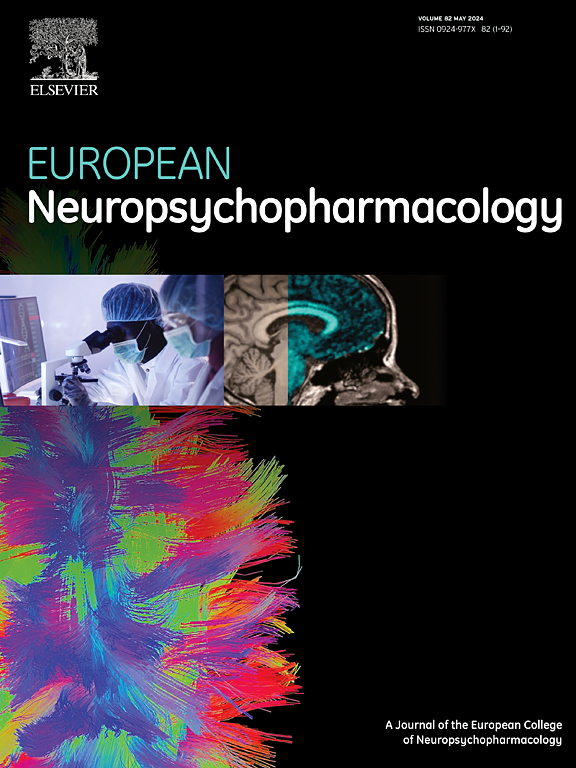使用曲线下面积(auc)量化个体抑郁症状在生命过程中的负担:全基因组关联研究(gwas)的另一种表型
IF 6.7
2区 医学
Q1 CLINICAL NEUROLOGY
引用次数: 0
摘要
抑郁症可能是一种慢性、波动的疾病,但大多数研究依赖于症状严重程度的横断面估计,无法捕捉到个体随时间的轨迹。本项目采用纵向人口数据和多层次增长曲线模型,采用AUC方法量化个体水平的抑郁症状负担。这种方法提供了一种可扩展的,可解释的,理论基础的替代抑郁症的先前横截面表型。该项目使用了来自英国生物银行(UK Biobank)的约49万名成年人的数据,并在8次中重复测量了2项患者健康问卷(PHQ-2)。在Stata 18.5中使用MLwiN拟合混合效应模型。模型包括年龄、年龄平方和年龄立方的固定效应,以及年龄的随机截距和斜率,以捕获症状发作和线性变化的个体偏差。年龄以均值为中心,以提高可解释性并减少多项式项之间的共线性。个体特异性的预测症状轨迹来自估计的模型参数,包括固定和随机效应。然后使用梯形规则计算每个个体的AUC,整合观察时间点的预测PHQ-2分数。这导致连续测量累积抑郁症状负担量表在不同随访时间的个体之间的可比性。由此得出的AUC值分布体现了个体间的显著差异,分数越高,症状持续时间越长,强度越大。然后使用REGENIE使用该表型运行GWAS,控制主成分,去除基因型缺失的snp >; 10%, INFO <; 0.1和HWE p >; 1e-15。REGENIE使用两步方法,实现快速全基因组回归建模。鉴定出2个先导snp。该方法解决了传统表型方法的三个关键局限性:(1)它保留了纵向结构,避免了任意的截止点;(2)它可以比较个体之间的终生症状负担;(3)它通过灵活的多层次建模来适应不同的观察时间表。我们讨论了使用AUC作为精神病学基因组学表型总结的意义。例如,与特定时间点症状评分相比,基于模型的预测得出的累积负担如何可能作为全基因组关联研究的更稳定和可解释的结果。我们的工作证明了纵向建模与AUC集成如何为捕获生命过程中的动态心理健康过程提供了强大的工具。本文章由计算机程序翻译,如有差异,请以英文原文为准。
QUANTIFYING INDIVIDUAL DEPRESSIVE SYMPTOM BURDEN OVER THE LIFE COURSE USING AREA UNDER THE CURVE (AUC): AN ALTERNATIVE PHENOTYPE FOR GENOME-WIDE ASSOCIATION STUDIES (GWAS)
Depression can be a chronic, fluctuating condition, yet most research relies on cross-sectional estimates of symptom severity that fail to capture individual trajectories over time. This project used longitudinal population data and multilevel growth curve models to quantify individual-level depressive symptom burden using AUC methods. This approach provides a scalable, interpretable, and theoretically grounded alternative to the prior cross-sectional phenotype of depression.
This project used data from the UK Biobank of ∼490,000 adults with repeated measures of the 2-item Patient Health Questionnaire (PHQ-2) across eight occasions. A mixed-effect model was fitted via MLwiN in Stata 18.5. The models included fixed effects for age, age-squared and age-cubed, and random intercepts and slopes for age to capture individual deviations in symptom onset and linear change. Age was centred around the grand mean to improve interpretability and reduce collinearity between polynomial terms.
Person-specific predicted symptom trajectories were derived from the estimated model parameters, incorporating both fixed and random effects. The AUC was then calculated for each individual using the trapezoidal rule, integrating predicted PHQ-2 scores across observed time points. This resulted in a continuous measure of cumulative depressive symptom burden—scaled for comparability across individuals with varying follow-up durations. The resulting distribution of AUC values captures substantial inter-individual variability, with higher scores reflecting longer duration and greater intensity of symptoms over time. This phenotype was then used to run a GWAS using REGENIE, controlling for principal components, removing SNPs with genotype missingness > 10%, INFO < 0.1, and HWE p > 1e-15. REGENIE uses a two-step method that enables rapid whole-genome regression modelling. 2 lead SNPs were identified.
This method addresses three key limitations of traditional phenotyping approaches: (1) it preserves longitudinal structure and avoids arbitrary cutoffs, (2) it enables comparison of lifetime symptom burden across individuals, and (3) it accommodates varying observation schedules through flexible multilevel modelling.
We discuss the implications of using AUC as a phenotypic summary in psychiatric genomics. For example, how the cumulative burden derived from model-based predictions may serve as a more stable and interpretable outcome for a Genome-Wide Association Study compared to timepoint-specific symptom scores. Our work demonstrates how longitudinal modelling combined with AUC integration provides a powerful tool for capturing dynamic mental health processes over the life course.
求助全文
通过发布文献求助,成功后即可免费获取论文全文。
去求助
来源期刊

European Neuropsychopharmacology
医学-精神病学
CiteScore
10.30
自引率
5.40%
发文量
730
审稿时长
41 days
期刊介绍:
European Neuropsychopharmacology is the official publication of the European College of Neuropsychopharmacology (ECNP). In accordance with the mission of the College, the journal focuses on clinical and basic science contributions that advance our understanding of brain function and human behaviour and enable translation into improved treatments and enhanced public health impact in psychiatry. Recent years have been characterized by exciting advances in basic knowledge and available experimental techniques in neuroscience and genomics. However, clinical translation of these findings has not been as rapid. The journal aims to narrow this gap by promoting findings that are expected to have a major impact on both our understanding of the biological bases of mental disorders and the development and improvement of treatments, ideally paving the way for prevention and recovery.
 求助内容:
求助内容: 应助结果提醒方式:
应助结果提醒方式:


